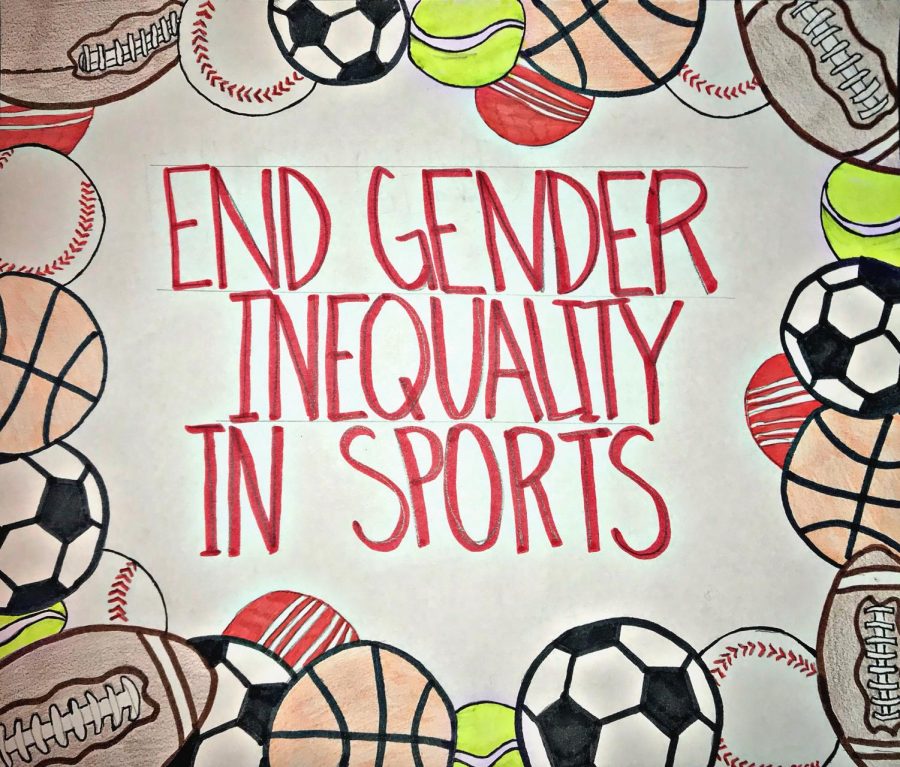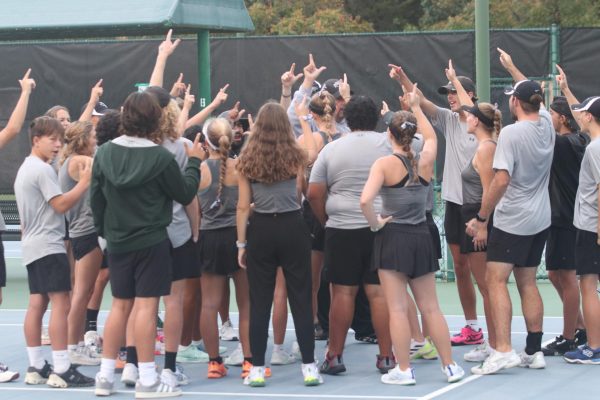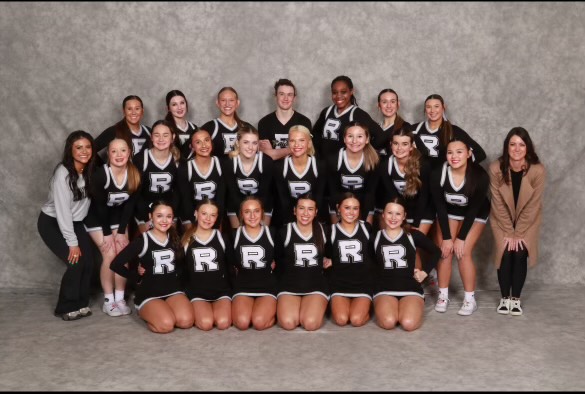Women Treated Differently in Sports
A common stereotype in the sports community is that women’s sports are inferior to men’s sports. Sporting environments have degraded female athletes by constantly holding them to a lower standard than male athletes. They are more likely to be objectified, shamed, and paid less because of another stereotype that men are more athletically gifted.
Realizing the built-in microaggression towards women will allow society to change for the better and we could finally get rid of gender inequality.
Compared to some sports, male and female athletes are definitely portrayed differently, especially in what they wear. A great sport to compare is football. Although it is considered to be a predominantly male sport, many women do play professional football. Male athletes usually wear gear and padding to help prevent injury. While women’s football, they tend to wear a little more revealing uniforms with not as much protection or padding. It’s confusing because it’s the same sport that could cause the same amount of injury; however, because they’re a different gender, they have to dress differently. It seems to appear that the audience is focusing more on the way they look, instead of how much talent female athletes have. This could cause many female athletes to develop eating disorders because they focus more on how they look instead of how they perform. Eating disorders could affect an athlete’s performance and they’re more likely to be prone to injury. Injuries could also be more difficult to recover from because they could be lacking nutrients from food. Obviously, the physique is very important in both male and female sports, but physical and mental health helps sustain a healthy body. Objectification of women happens in many other sports, such as tennis, volleyball, cheerleading, ice skating, etc. Men and women shouldn’t have to dress according to their gender. They should wear according to how intense the sport is.
Stereotypes, social constructs, and gender roles are restricting our younger generation from being who they want to be.
— Mariam Alashmawi
In sports, women don’t get as much respect as men do. This has to do with the normalization of stereotypes that are in the sports industry. Many female athletes have to deal with more microaggressions and discrimination than male athletes do. Also, only 40% of sports participants are women and only 4% of women’s sports have sports media coverage. This could be discouraging to young girls who aspire to be an athlete but not having any role models to look up to. Because of this teenage girls are 2 times more likely to drop out of sports than boys. Having as much media coverage as male athletes would encourage them to stay in sports. Not only does our younger generation have less female athlete role models, but some also lack opportunity and lack experience because funds usually go to boys’ sports and/or they live in a poor community they naturally lack resources which makes it difficult for young girls to engage in sports. The social stigma around female athletes also tends to be very negative and stereotypical. The idea that girls are supposed to be quiet, obedient, feminine, care-givers, and nurturers is absolutely ridiculous. For years, sports have been considered a “masculine” thing. However, once a girl challenges and confronts the idea, she’s questioned for not being “ladylike.” They’re questioned about their gender identity and sexual orientation because of these stereotypes. Sports shouldn’t be labeled as masculine or feminine. If a girl wants to play football, let her play football. It goes the same for boys that prefer ballet over other sports. Stereotypes, social constructs, and gender roles are restricting our younger generation from being who they want to be.
Female athletes that work just as hard as male athletes should be getting paid as much as them and they should also have just as much media coverage.
— Mariam Alashmawi
Gender inequality feeds into a major issue in the U.S today, the wage gap and income inequality. Comparatively, many female athletes make far less money than male athletes. For example, Sue Bird who has played 17 seasons in the WNBA and won 4 WNBA Championships, had a 2020 salary of $215,000 and gets an $11,356 bonus for winning the 2020 finals. LeBron James has also played 17 seasons in the NBA and has also won 4 NBA Championships, however, his 2020 salary is $37.44 million and gets a $317,000 bonus for winning the 2020 finals. There is a huge gap in wealth, although they have accomplished the same level of achievement. This feeds into the fact that women don’t get as much media coverage and they don’t get the respect they deserve. Female athletes that work just as hard as male athletes should be getting paid as much as them and they should also have just as much media coverage.
Some people have become so compliant to their gender roles that they don’t realize how sexist the world really is. It is especially important to realize sexism in sports because many athletes that make it big are going to be role models for the younger generation. The sexist stereotypes are going to make younger people rebel against the stereotypes. The fact of the matter is women are treated differently in sports. They get objectified more often, they get disrespected more often, and they don’t get paid as male athletes. Women’s sports are just as important as male sports.

Mariam Alashmawi is a senior and this is her second year as a staff writer for the Silver Streak.














Andrei • Jan 18, 2023 at 2:53 pm
just to be clear about one thing, at the moment the wnba is non profitable and it is said that they lose 10 million per year because of this and it is not because of the media. the people that support wnba players the most are actually nab players that give some of their salary to fund the ladies, the most lacking point is the fact that the rims are at the same height as in NBA. women do not develop as much physically in terms of height and muscular mass as a male athlete and having the same height is unfair. if the rims would be lowered to allow for alley oops and more dunks to make the game more interesting then it would be a lot more entertaining. there is also a different level of determination. people like LeBron spend so much time to train and make sure that their perfect same with Kobe Bryant and other basketball players. comparing the two different leagues is unfair for the wnba as the NBA is more capable and better as males grow bigger and stronger than women in general. this is why you do not have mixed sex Emma fights.
Kayla • Jun 21, 2021 at 6:36 am
@nathan guzman nobody is reading all that and what you’re doing is invalidating the article and downplaying the fact that women athletes deserve equal pay (also diverting the topic on hand). Lebron and sue playing 1 on 1 has nothing to do with the article about working hard. Question: by your logic if lebron played against a bench (in the nba) and the bench player loses then that player don’t deserve his pay??? Simply because he lost to lebron just like how sue might lose. If that’s the case then half the players in any male sport don’t deserve that money.
jazzy lee • Oct 24, 2021 at 7:10 pm
exactly my thoughts. the argument isn’t that female athletes are better than men, it’s just the simple fact that they aren’t getting paid as much for playing the same game!!! there are undoubtedly tons of professional MALE players who would lose 1 v 1 against lebron james, yet you don’t see their salaries getting cut in half for it. nowhere in the article do you see the author arguing that women should play on the same teams as men…. stupid argument @nathan guzman
nathan guzman • May 18, 2021 at 1:39 pm
LeBron James doubles her stats in a harder league. (sue bird)And you look good on tv because you are good, and yes women work hard but men can biologically work harder. Have you played a sport that has both males and females? have you played sports? I mean if you did you would know how much of a factor that is in any sports. Women can play better in some instances but name one female in the NBA,NFL,or NHL. You can’t. there’s a reason there are two leagues for most sports. look up the mixed Olympics 400 meter race. You would see how much of a biological advantage men have over women. Sure there are the genetic outliers. but even then they can’t compete with the top on percent of male athletes. Florence GRIFFITH-JOYNER ran a 10.49 one hundred meter dash, Ato Boldon is a high school sprinter that ran a ten flat 100 meter dash. did I forget to mention that Florence ran that time in the Olympics. joseph pena another high school athlete squatted over 1000 lbs. yes with three zeros. Jason Hartman competed in the worlds powerlifting tournament and squatted 854. I didn’t go on a limb and say women for the most part aren’t as biologically gifted as men I showed facts.
Arianna barer • May 15, 2021 at 9:45 pm
its the fact that you work hard ok women do get treated differnt men don’t like that woman can play better sometimes but we all work to get to that place so i feel like it should be based on there work and there consideration to the game
Katie Carpenter • Jan 19, 2023 at 1:36 pm
Yes but there are more ways to see that women can be athletes. Not only do you need the work and consideration of the game, but you need the proof of it!
taleyah • May 11, 2021 at 8:47 pm
lets be real here just cause lebron looks good on tv doesnt mean sue bird couldnt beat him… the only think he has against her is his build and strength and the fact he can dunk
jonas • Dec 9, 2022 at 11:25 pm
you know what makes the men more money is their build strength and the fact they can dunk lol
nathan guzman • May 5, 2021 at 1:26 pm
Lets just be real here, if you got sue bird and LeBron James in the same court she would get smashed. This isn’t a microaggression this is a fact. Men are just built different.